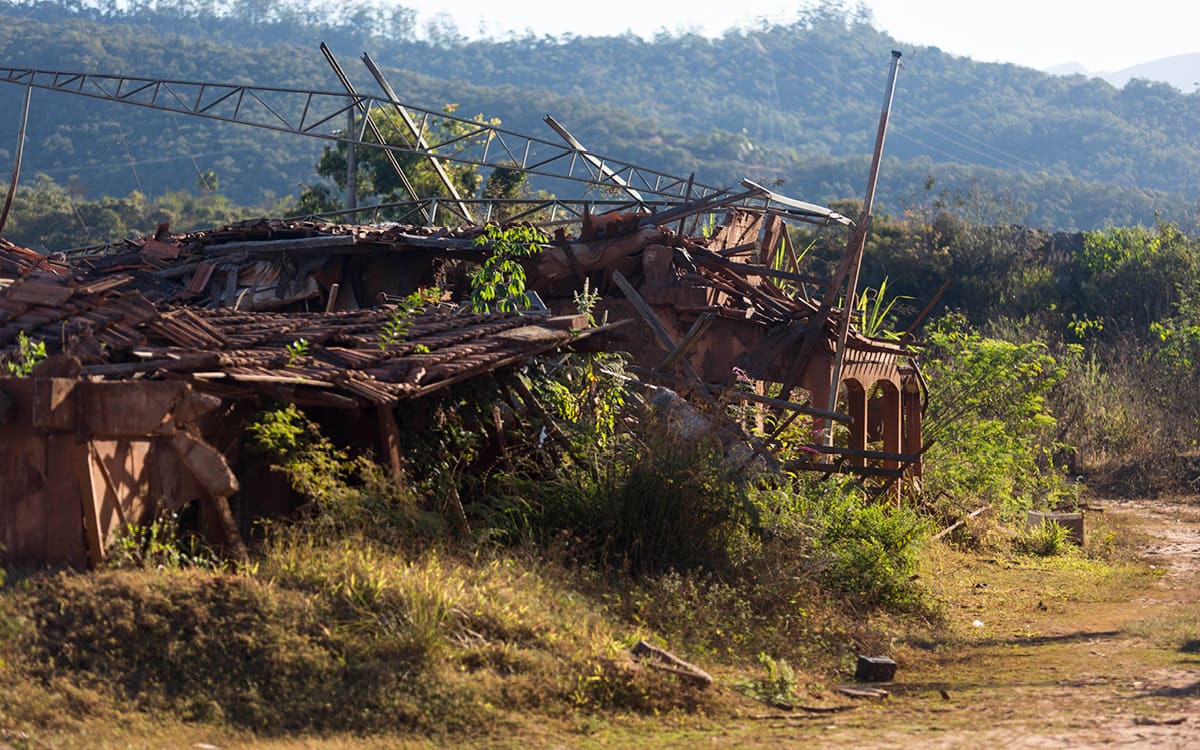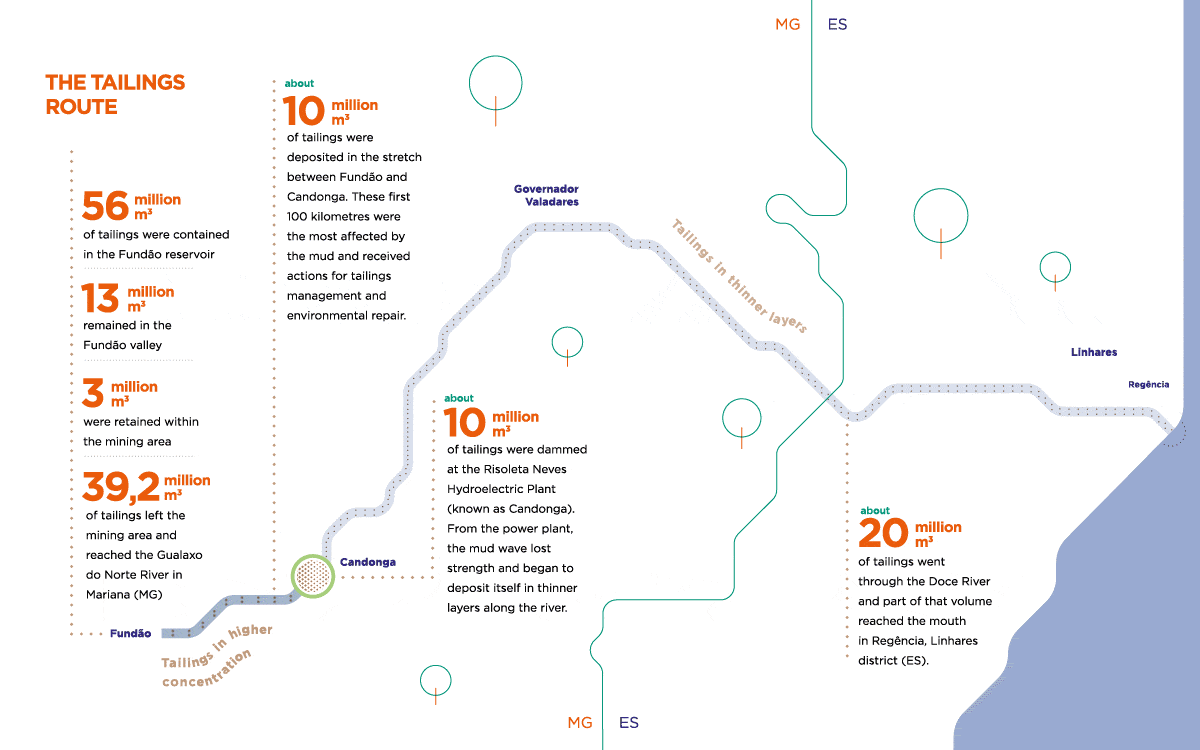Special
INTEGRATED REPAIR
THE DAM FAILURE
The Fundão dam failure, in Mariana (MG), occurred on November 5th, 2015, when approximately 39,2 million cubic meters of tailings reached the Gualaxo do Norte River, in Mariana, from where they flowed into theDoce River and on to the river mouth.
Along this route, 19 people died and a series of specific impacts occurred in each stretch as it passed through 39 municipalities (*) from Minas Gerais to Espírito Santo States, over 670 kilometres.
In addition to the serious environmental impacts, the tailings dam failure in Mariana resulted in social and economic damage, and the social component stands out as the driving force behind the challenges the repair process needs to overcome.
THE SOLUTION MODEL
The model defined to repair the impacts is the result of a Transaction and Conduct Adjustment Term (TTAC) signed in March 2016.
An agreement among dozens of entities, including Federation bodies, such as Ibama, ICMBio, ANA, state and municipal agencies, Samarco, Vale and BHP companies and representatives of the basin committee, established the guidelines on how the process would be developed.
The actions were divided into two main fronts. The first is the repair itself, aimed at reversing or decreasing the impacts caused by the dam failure – this includes tailings management, the reconstruction of villages, and indemnities. The second is compensation, to reimburse society for the general damage in people’s lives – forest restoration, spring recovery and sanitation for the municipalities along the Doce River are some examples.
TTAC also established that the recovery of the Doce river would be conducted by an autonomous organization, 100% dedicated to repair and impact compensation activities. Thus, the Renova Foundation was created.
The Foundation is the entity responsible for mobilizing and carrying out the repair. It brings together technicians and specialists from different areas of knowledge, tens of socio-environmental and scientific knowledge entities from Brazil and the world, and today it adds up to about 7 thousand people (including its own collaborators and partners) working in the repair process, from Mariana to the Doce River mouth. More than 25 universities and 40 NGOs and partner institutions are also engaged.
It is a non-profit organization, structured in an unprecedented model of governance to repair damages caused by the Fundão dam failure.
TTAC is an innovative option to the conventional model of judicial solution of conflicts and defines the scope of work of the Renova Foundation, formed by 42 programs and projects which are under way from Mariana to the Doce River mouth.
These programs are divided into three main areas of integrated action.
People and communities
Dialogue, registration, indemnities, fostering the economy, education and traditional and indigenous communities
Land and water
Tailings management, water provision, land use, forest restoration, biodiversity and assistance to animals
Reconstruction and infrastructure
Resettlement, water and effluent treatment, urban infrastructure and accesses and tailings containment
GOVERNANCE
By establishing an organization exclusively dedicated to the repair process, a complex governance model was also created, with the presence of over 70 entities. The answers to each challenge are obtained together, and no engaged party has complete control over the decision.
TTAC formed the Interfederative Committee (CIF), a collegiate system that brings together representatives of public bodies and society and is led by Ibama. CIF operates as an external and independent instance of the Renova Foundation , with the function of guiding, following, monitoring and supervising the implementation of repair measures. It has 11 Technical Chambers – consultative bodies set up to assist its work.
In the internal instances, the Curator Board, composed of representatives appointed by CIF and the companies Vale, BHP and Samarco, is responsible for approving plans, programs and projects proposed by the Renova Foundation Executive Board.
The Advisory Board, made up of affected communities’ representatives, basin committees, Ibama and academic institutions, represents society within the Renova Foundation. Its role is to provide an opinion on plans, programs and projects, in addition to indicating proposals for solutions to the damage caused by the dam failure. On the other hand, the Fiscal Board is responsible for inspection activities, accountability and compliance of the finances.
Since the beginning, the Renova Foundation activities have been monitored by the Public Prosecutor’s Office of Minas Gerais Foundations, which ensures the accomplishment of the goals and operation of this model of repair, hitherto unprecedented in Brazil.
All repair actions carried out by the Renova Foundation are verified by an independent external audit, which ensures transparency in the monitoring and inspection of the investments made and the results achieved. It is a complex governance, with about 400 people participating in a collegiate process, with shared control between the various actors.
Externally, a panel was also set up with the International Union for Nature and Natural Resources Conservation (IUCN) to monitor the evolution of the scientific components of the process as a whole.
TAC GOVERNANCE
In June 2018, a new commitment was signed, the TAC (Conduct Adjustment Term) Governance, which incorporated the participation of those affected in all instances of the repair decision-making process, improving the model of collective solution construction.
TAC Governance has established the creation of regional chambers and local commissions, which are being organized with the support of independent technical advisors and will represent the affected communities. Representatives of these chambers and committees will be members of the Interfederative Committee (CIF), the Curator Council and the Renova Foundation Advisory Council.
Within the system established by TAC Governance, the general ombudsman was hired by the end of 2019 with the mission of deepening the dialogue with those affected. Also, within the TAC Governance, an Observers Forum will be formed, an external body to the Renova Foundation which is composed by representatives of civil society, academy, peoples and traditional communities affected. The Forum will aim to monitor what is being done in the recovery of sites impacted by the dam failure, subsidizing the Public Prosecutor’s Office of Foundations.
3 questions about TAC Governance
What has changed with TAC Governance?
The TAC Governance made room for the direct participation of those affected in the decisions of the Foundation’s repair actions. Those affected now have a seat in all instances of Governance, including the CIF, Technical Chamber and Curator Council.
In practice, what does this mean?
It means that communities now have the right to vote and an effective participation in decisions about the repair process. Which means, the participation of those affected enters into a higher level of power, which is deliberation. So far, those affected had the right to speak and their participation used to happen indirectly, either through the Advisory Council, in structuring some programs or organizations such as the Basin Committee. Now they will also have voting rights. The Renova Foundation welcomes the increased presence of those affected in the governance system as a fundamental step towards greater community participation in the repair process, increasing the legitimacy of all its decisions and actions.
How will the affected people indicate their representatives in the governance of the Renova Foundation?
Those affected people will sovereignly choose from 21 local commissions and six regional chambers that were also created by TAC Governance.



